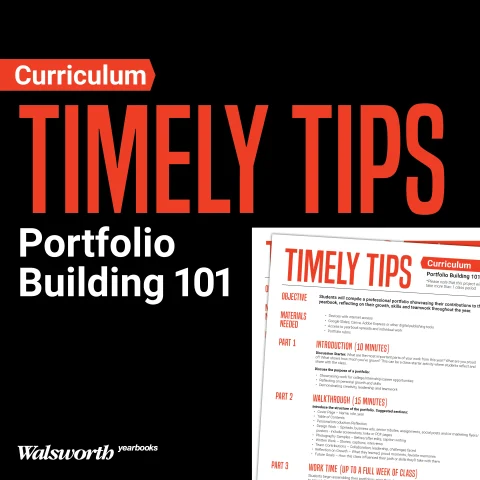Brainstorm. Any word with “storm” in it must be fairly intense. When you brainstorm for story ideas, dozens of thoughts are going through your mind at once. You may be using your brain, but brainstorming can be a gut-wrenching process. However, there are ways to capitalize on the process to make it more useful. Brainstorming for story ideas is a year-round activity for the yearbook staffs at three high schools where the advisers have tried-and-true methods for helping their students through the process.
Step-by-step process
Robin Sawyer, adviser at Manteo High School, Manteo, N.C., gives the search for story ideas as an assignment at the beginning of every school year.
“I throw out a question one day and ask everyone to bring in answers to that question the next day,” she said. “They spend some time at home thinking about it, so they have something in front of them when they return to class.”
Then the next day in class, the students on the Sandfiddler staff present their ideas.
“My biggest problem in brainstorming is having them discuss it,” she said.
Sawyer tells her students that the point of the brainstorming session is not to debate every idea but just to put all of the ideas out there. She tries to keep these discussions to 30 minutes, but many times it takes 60 minutes or more.
Deadlines dictate what stories the staff will work on first, usually Student Life and Senior people. But that first brainstorming session will help with future sessions.
“We keep the original list. When we are ready to look at the underclassmen, now we’ve got some ideas that we might be able to use on other sections. We put those ideas back on the table,” she said.
The Manteo yearbook is an August-delivery book.
“We brainstorm throughout the year,” she said. “We try not to lock ourselves in back in August or September. That’s why we do brainstorming at different times, so we have flexibility in changing.”
Next, after all ideas are on the table, the discussion turns to eliminating the bad ones.
“If the idea has no photo possibilities, you don’t want to waste space on it,” she will tell them.
“I stand in the back (during the discussion) and say, ‘Think picture,’ ‘Think color,’ ‘What are our photo opportunities?’ Testing ideas is part of the discussion, and photography plays an interesting role in that discussion. It’s key to the decision-making process,” she said.
Once the bad ideas are gone, then the students review the remaining ideas and determine which would be good main stories and which would be good sidebars. The stories then are marked “M” and “S.”
“Then we take that list and sleep on it a night or two. Then the editors review it, then they go to the staff and see if they agree,” Sawyer said. “It works for us.”
Well, most of the time. Sawyer said if the brainstorming list appears weak, she will have the staff research using popular teen magazines, other yearbooks, other school newspapers, and the internet.
And what if a story is a valid story idea but the photography possibilities are nil?
“Hey, Q and A,” Sawyer said.
Just ask them
The staff of Robert Haar, adviser at Thousand Oaks High School, Thousand Oaks, Calif., came up with another way to brainstorm this year while they were in the process of brainstorming.
Each year the staff attends a summer workshop, where the students usually start with some initial theme ideas and end the camp with a totally different, yet better, idea. In between, Harr and the advisers teaching the workshop question his students to help them determine if they have come up with a good theme.
“Most of my questions are to get them to look at the whole picture of what they want to say, to understand the importance of creating a theme that says what they want to say,” Haar said.
Once the theme is in place, Haar uses different methods with his staff to come up with story ideas that are in line with the theme. A few years ago at a workshop, Haar picked up a questionnaire on the mini-cultures within a high school. His students take that questionnaire each year in an effort to see if those cultures are reflected in the current year’s theme. The staff also discusses staff interests to see if they may be shared by a larger group of students in the school, and therefore need to be covered.
But this year, the staff developed a questionnaire to help them confirm their story ideas and come up with new ones. Every student in the school received the 10-question survey through their English classes. The students were asked to put their name on them and were told the answers would be confidential, but they may be contacted to be interviewed for a story.
The theme of this year’s Lancer Legend is epiphany, and the staff was looking for stories about realizations students reached in their lives and how they came about. The questions on the survey were personal, such as what daily sacrifices they make; what is something nobody knows about you; and what childhood antic helped instill a lifelong lesson.
The answers on the questionnaire were beneficial to the staff. For example, it confirmed the validity of the childhood antics story.
“That helped us know that we had a story and we knew where to get it. So we got a bigger cross section of the school,” Haar said.
“It (the questionnaire) allowed us to meet new people and get those stories we normally wouldn’t get. It gave us more of a structure and purpose than in the past.”
Divide and conquer
Karen McCarty, Laney High School, Wilmington, N.C., splits her Spinnaker staff into teams assigned to different sections of the yearbook. The teams list the things that are happening related to their section and develop their story ideas from that. McCarty calls it her “divide and conquer” strategy, and this is the second year she has organized her staff this way. She developed the team approach because the newspaper and yearbook staffs are combined, and students usually cover the same beat for both publications, she said.
The staff will have a brainstorming session for the entire year in August, then do more brainstorming as they begin to work on each section.
McCarty said the team approach has worked well for her staff, but the students have to buy into it for it to work.
“Making them part of a small group helps them work within the larger group. It helps them blossom,” she said.



